“Always do your due diligence but let your imagination exceed your capabilities” – Gundam developer, 1980s
Shit Work
The dung beetle loves to work. It can move up to 1000 times its own weight, often continuing until there is no more load to move. But it is unusual to have more dung around than beetles, as they are industrious and can marshal quite a large number to do this important work. Not only do they clean up after the herbivores they keep the environment free of other pests. They benefit from the nutrition and source of supporting their off-springs. The coprophagous specie eats the excrement of other organisms, usually vegetative waste. So there are rollers, dwellers or tunnelers according to whether the load can be moved or just eaten as it is. And walking on their forelegs, rolling seems easier using their rear legs, at least they know where they’re heading, backwards. They are Nature’s garbage trucks, the scarabaeidae beetle specie – imagine what happens to a city if nobody wants to work as garbage collectors, unless they are automated for an entire city. There was a time in our schooldays when there were no modern sanitation a favorite ploy was used by teachers or parents to encourage studying. Either you do well and get a job or become a night-soil carrier. But the humble dung beetle seems to enjoy this. And it has become harder to find modern workers for menial tasks – a good secretary for instance can be paid better than a doctor. This is the story of Phip the dung beetle who likes to race. He is a roller and speed is his thrill. All day or night he would go find groups of elephants, deer or buffaloes and starts his marathon. And he does have competitors – ask those dozens of those who race with him and you’ll get a laugh. So one hot summer’s day Phip lined up with his two competitors Dlip and Flip to start a race. The referee ensured all have about the same dung size and the one reaches the colony dung-hole wins. Phip was all confident, sneering away at the other two who hasn’t beaten him even once.

The referee waited to twirl its wings as the starting signal. Then “blop!” a chunk of wet slimy dung fell on Flip, burying him completely. “Ha! ha! ha!”, Phip burst out laughing, “You’ve lost even before starting!”. But then before Phip could finish the sentence, another bloop of shit fell on him, burying him and splashing partly on the referee, who then twirled his wings. Dlip took off, pushing his dung ball up the slope. “You two dung critters will never catch me!”, as Dlip raced to the top of the slope. Phip and Flip recovered quickly, shaking the splatter off with their spindly legs and pushing their balls uphill with their front legs, backwards. But there’s one problem – dung beetles have no brakes. Just before they reached the top of the slope where Dlip was, Dlip’s dung rolled off downhill, leaving Dlip behind. “Aargh!”, Dlip shouted, as his dung-ball rolled off to the side into a puddle of mud. While the other two were laughing at Dlip, their dung balls also rolled off downhill. All three were screaming as their dung balls took off in different directions, each scampering downhill aimlessly, not knowing where their respective dung balls were. Soon Flip found a dung ball at the side of the mud puddle and proceeded to push upwards toward the dung colony. Finally all three reached home, Phip was second and Dlip last. The referee declared Flip the winner. “Not so fast!”, Dlip said. Wasn’t it my dung ball that Flip stole at the mud pool? So an argument started about who had whose dung. But nobody could say for sure and hence the race was declared incomplete. Though they had fun with dung, oftentimes their lives depend on it.
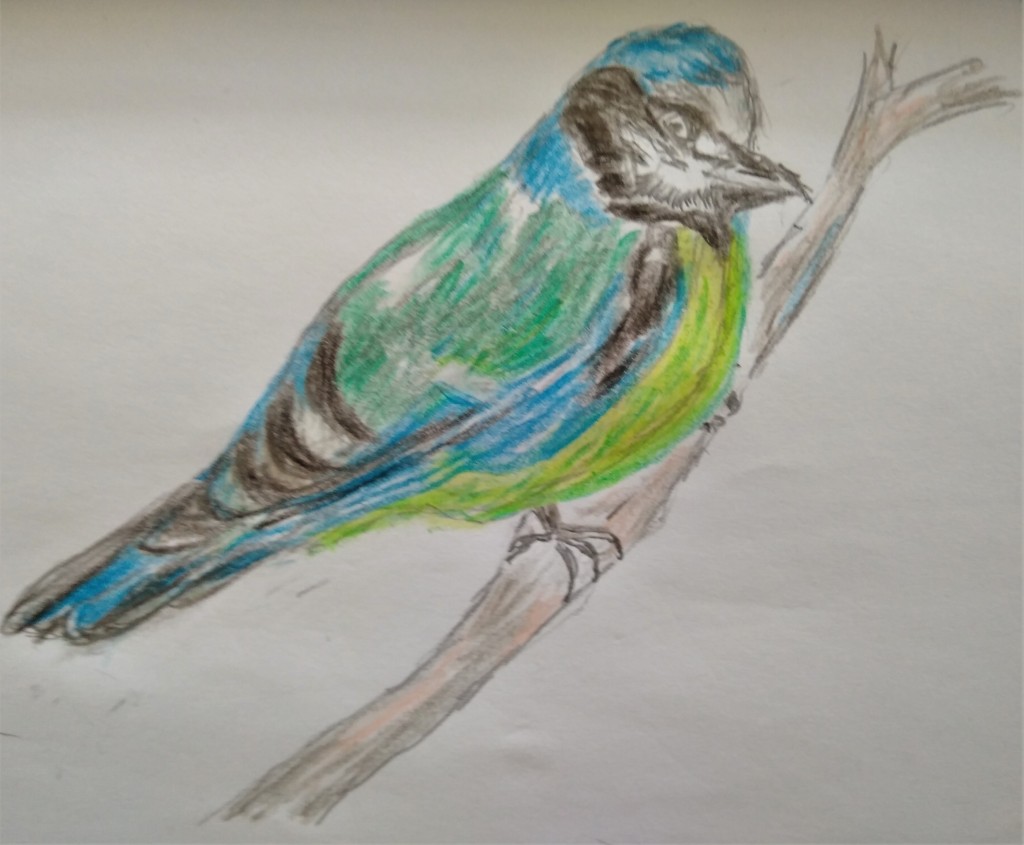
It happened on a chilly day in the Savannah. Phip just started collecting a huge elephant scat and after much effort arrived at his dung colony. Just as he was about to unload it, out of nowhere a secretary bird landed nearby. Now a secretary bird is about the fiercest avian raptor of the African plains. They can easily stomp to death poisonous adders and cobras with their stout clawed legs and dispense animals far larger than themselves. They are such avid hunters with such a harmless name – secretary because behind their heads are hanging plumes of black feathers that appeared like writing pens behind the ears of scribes. This time it appeared that food was scarce and beetles became easy fare. It had easily picked up Dlip and several of the beetle family, and now turned towards Phip. Instinctively he crawled behind the large dung ball to hide, but couldn’t fool the plucky predator for long. Just as the bird turned behind the ball to peck at Phip with its eagle-like beak, he quickly tunneled into the dung ball. The bird wasn’t about to give up. It started pecking at the dung, trying to break it up. Phip, desperate now had one last trick up his sleeve. He knew that the dung was fresh and soft. So he twirled his wings, stirring up the fresh dung like a food-processor. All of a sudden a cloud of ammonia and pungent nitrogenous gas burst forth towards the bird. Taken aback it retreated and turned to other easy insects around. So Phip got to live another year – the last year of his 3-year life. He had already produced two generations of children out of dung. If you think a dung beetle’s life must be shitty boring, wait till you hear how his life ended.
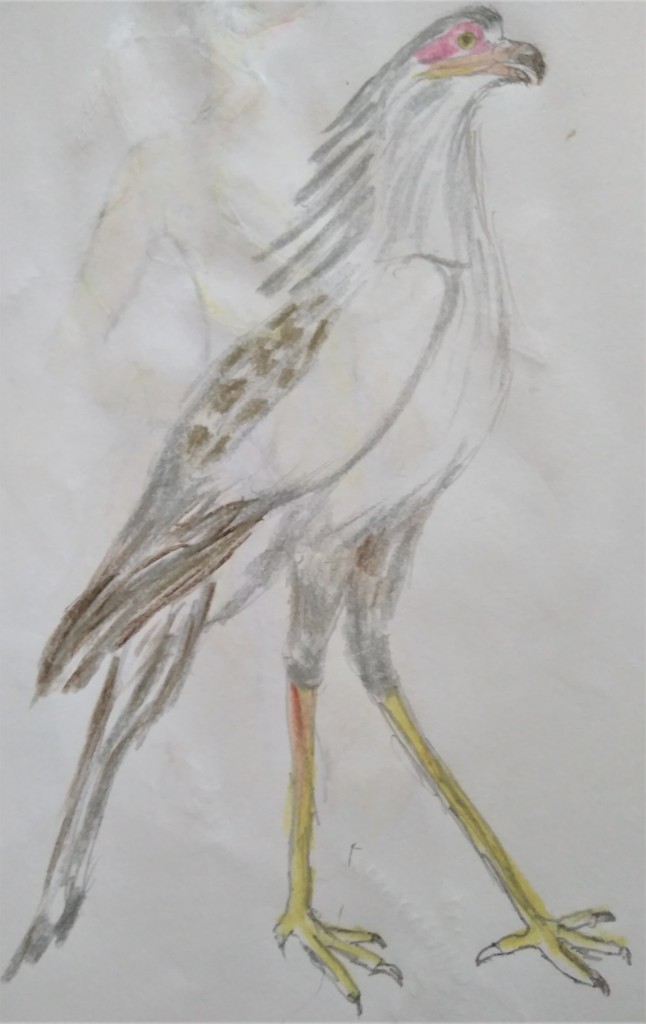
It was a cool spring day and out of Phip’s dung colony scores of baby beetles emerged. There were about 2 millimeters size, all ready to eat the half-digested vegetation available all around. Then another sudden visitor landed next to them. It was a bullfinch and insects of the size of Phip’s babies were its favorite. Phip sprang into action, running towards the babies and covering them with his body. The bullfinch could not peck at the size of the adult beetle and was defeated. But just after it flew off another shadowy figure appeared. It was the secretary bird again and this time Phip had no dung to hide. In a flash its talons pinned Phip to the ground and with a swift bite, pulled Phip apart. So the sacrificial death of Phip is just one ordinary daily event of life in the wild. Every creature lived to their obsolescence and dying to renew life with the next generation. It seems that only humans consider Death such a big deal – animals accept their fate as a matter of fact. And move on.
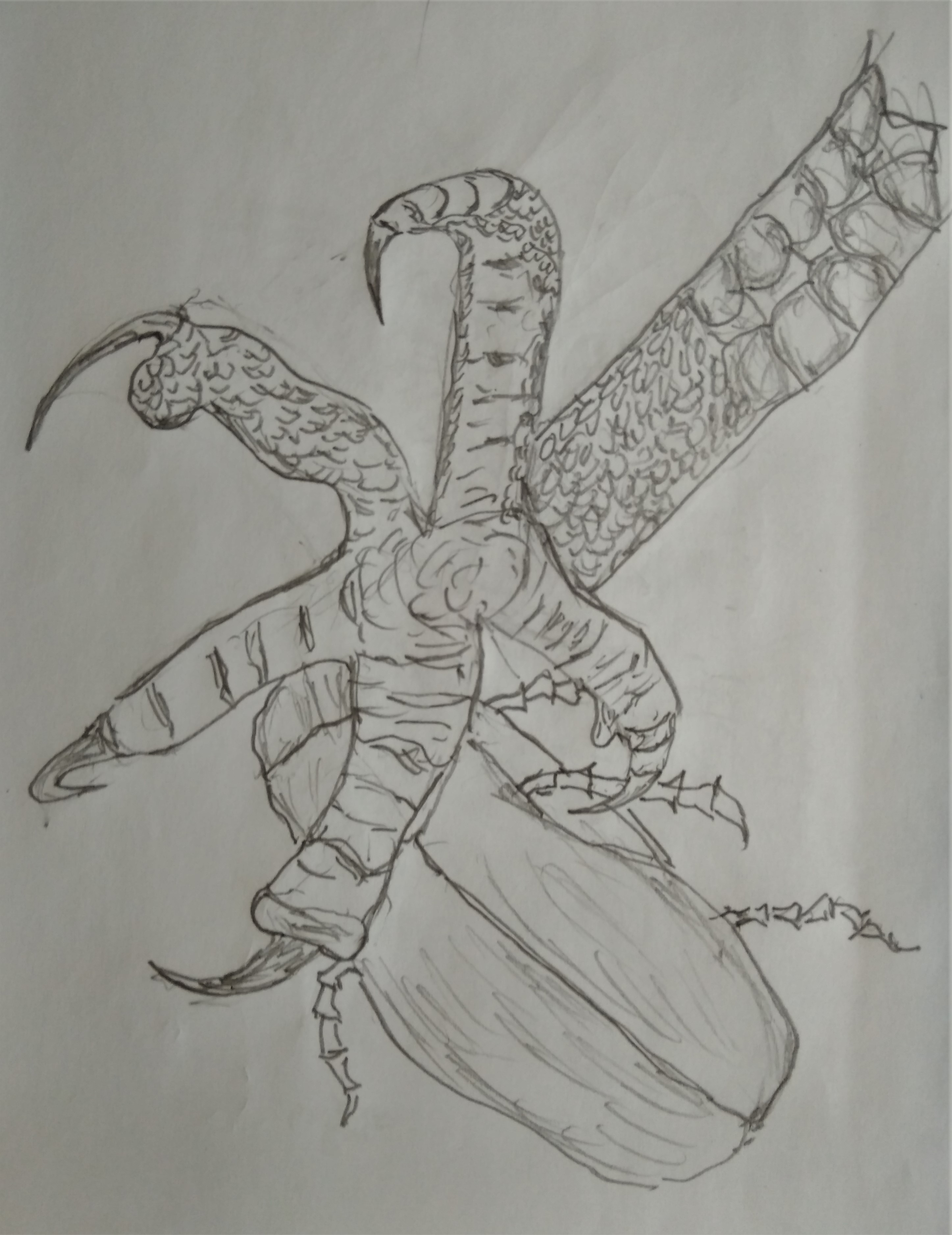
Congrats! He’s pregnant
Any of you males out there who would like to know what it is like to be pregnant become a seahorse. The 45 species of marine fish in the genus hippocampus have their reproduction roles reversed. The male would allow his favorite willing female to deposit her eggs, up to 1500 in number in his ventral pouch, which he would promptly fertilize. Then after carrying the babies up to 45 days impregnated, he gives birth. They come in various colors from brown to greenish or reddish – some are fatter, have shorter snouts or longer tails but they all have a common trait – slow moving. So slow as to be graceful dancers in the currents. But they eat like lightning, sucking in copepods like magic. This is a story of Kurio the dancing seahorse. He is slim but strong, dancing against currents and lead dancer of a troupe of seahorses in the Andaman sea.
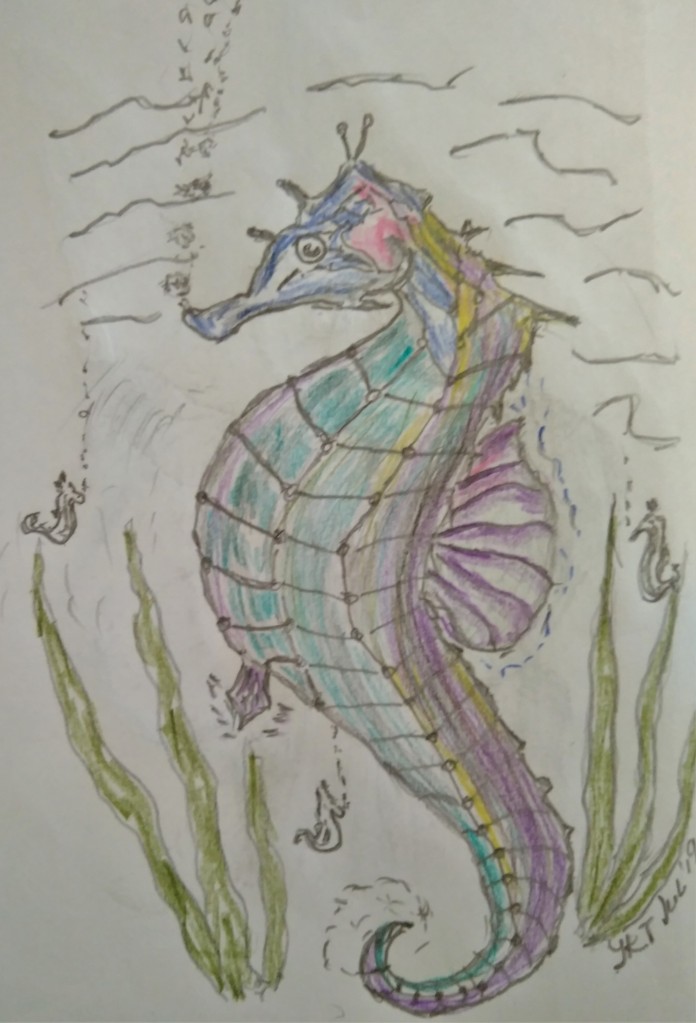
Without the ocean human beings would vanish shortly. It produces over half of the world’s oxygen and absorbs 50 times more carbon dioxide than our atmosphere. Covering 70 percent of the Earth’s surface, it transports heat from the equator to the poles, regulating climate and weather patterns. With human activity identified as the principal cause of greenhouse gas emissions, the resulting climate turmoil not only makes human communities hardly liveable but eventually robs humans of life-sustaining oxygen in destabilizing complementing fauna and vegetation cycles. Yet while protecting our oceans from pollution and global warmth is hardly done today, dangers remain in the depths from undersea earthquakes. Damage from tsunamis are titanic and baby steps have been taken by certain earthquake-prone countries to predict them. But a marine study on the behavior of tiny marine creatures like sea-horses revealed surprising results.
Dave Tucker, a marine biologist was observing plankton life and marine ecology in the Southern Andaman sea. There the troupe of seahorses were feeding on the rich plankton and steering the current with their tiny fins. Suddenly they seem to swim in different directions. Dave could feel the sea floor moved. As far as he could see the ocean floor rose and fall, like a giant carpet slowly flopping up and down. He knew right away that a large undersea earthquake had occurred. Dave felt safe – he knew it was as long as he remained underwater. But the sound was deafening as a cataclysmic undersea earth movement played out before him. What about his boat topside? Surely the boat would have been swept off by huge tsunami waves. Dave cautiously ascended. When he reached the surface he could see the tsunami moving away from him like a giant fan, along with his relatively tiny boat. What of the seahorses? No issue – in fact they were dancing all along. Also courting around with their tiny fins flickering quickly. Kurio the lead male dancer had all the ladies to himself. So popular that any lady who fancied him merely needed to deposit their eggs in his pouch and have part of him for herself. Just like that. No aching love vibes, none of the wrenching romantic stir in the stomach or anywhere else and none of this jealousy nonsense. No wedding nor foreplay. How simple! In the human world today the perfect love, courtship, marriage and reproduction would have taken several iterations, some hair-pulling. That’s because animals have no social nor legal framework to start a family, let alone any complexity of spousal or family conflicts. But you know, some people still prefer the human thing. Then again animals also might have that sudden hazy look or the biochemical rush – just that our research hasn’t got there yet. If you think seahorses are queer wait till you hear about the angler-fish.
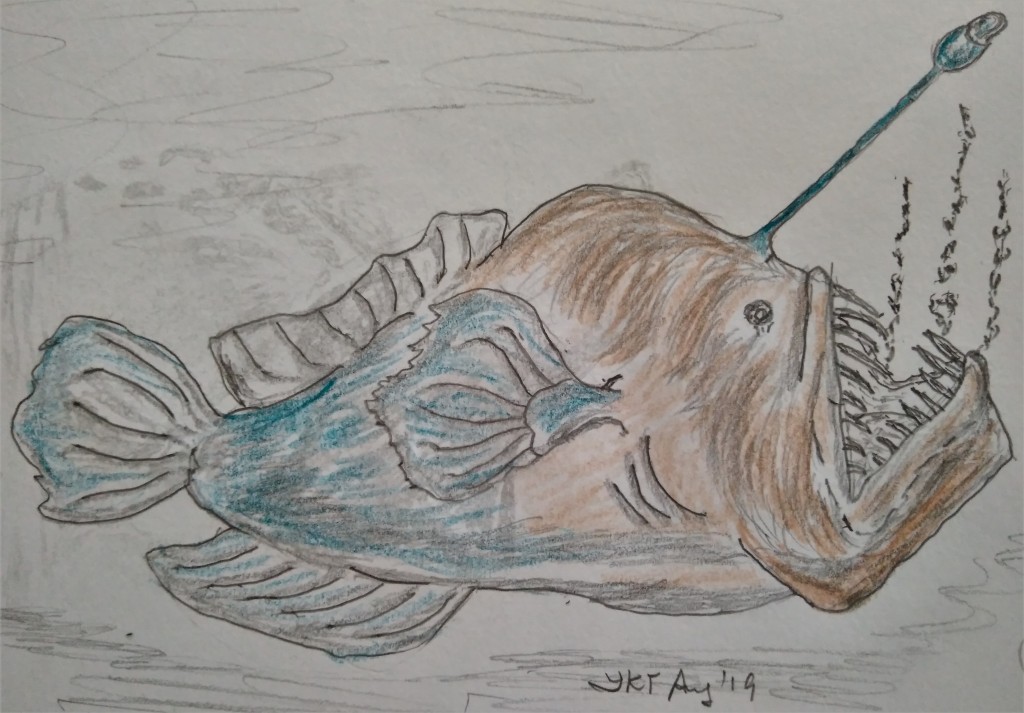
Broadly there are three groups of anglers (lophiiformes) – the pelagic (above sea floor), the benthic group stays on the sea floor and the deep sea bathypelagic group. In total about 120 species. The monk-fish and the frog-fish are also of the same family but lives on the continental shelf. Of interest is the deep sea group, with its angler lure of bacteria or fleshly bait at the end of a bony outgrowth from its head. The bacteria lure becomes luminous at the pitch-dark depth of 2000 meters. When time for reproduction the tiny male attaches to the female about 20 times its size, dissolves some of her flesh and becomes to her like a gonad – an addendum to provide her sperm for fertilization. What devotion! Except that he then is a part of her, surviving and living off her becoming part of her body. No permission needed, but this is not clear, because for humans, some females would and other females would’nt swoon for extreme devotion. Literally they then are one flesh in physical union. Talk about being mated for life. And of course divorce then is life threatening. Some men might even take up the responsibility of bearing a pregnancy to term becoming a seahorse, but to be physically attached to your soulmate – for life? Literally means until death do you part.
Heidi the improbable hyena
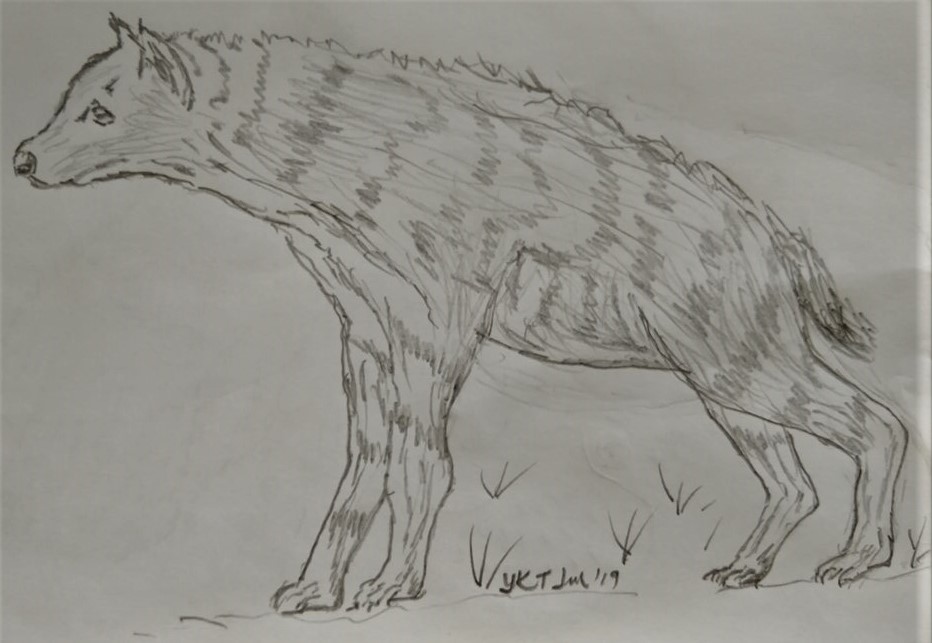
Hyenas are not everybody’s favorite animal. Thought to be scavengers, feral killers and thieves in the wild, you might even consider them cowards – stealing from the weak and maimed but living off the lords of the jungle. Some even think them related to witchcraft and demons – their devilish cries and screams during a raid reminds one of an attacking tribe of Red Indians encircling an embattled caravan of innocents. And they attack at night in droves – using their advantage in numbers to confuse any defendants of a kill, sniping away with their sharp teeth and grabbing chunks of carcasses before fleeing. But there is one hyena who is special – she is gentle and meek. Hiding behind her pack of marauders she never steals nor harass. She waits until the confusion ends, then picks up pieces of leftovers or meat droppings. One would have thought she would starve to death long ago, but she always had enough and has the knack of staying alive with her contrarian behavior. Lets learn of Heidi’s story and her meekness in adversity.

It was a hot summer evening. Heidi seem fat, but in fact she was lactating, carrying a brood of 6 to 9 to be delivered soon. But she must still join the hunting party – nourishment was key to giving healthy pups and the needed milk. So the usual rabble rousing as the pack accosted a lioness who just brought down a deer. Heidi held back in the bushes, patiently waiting as usual for discarded meat in the onslaught. She hoped that she’ll get lucky this time as she felt her tummy kicking inside for nourishment. She waited and waited. Several lionesses had gathered to defend their kill and chances for leftovers seemed slim. As she lay down in the brush she thought she heard a muffled bleat. She pricked up her ears and there was the bleat again. Her sharp scent picked up an animal hidden in the brush nearby. Turning here and there she finally found it – a newborn fawn – no more than a day old. It was lying so still hoping no predator could see her. Now what can a famished mother hyena do to a ready meal at her feet? But Heidi was different. Instantly the motherly instinct kicked in – she might have mistook the fawn for one of her babies that arrived too soon. Gingerly she laid down next to the shivering fawn, still wet from birth. And the fawn began to suckle Heidi’s milk. Poor thing, she must have thought, I was hoping to eat its mother from the kill.

But the tenderness didn’t last long. Out of the darkness two male hyenas appeared, sniffing the air for ready meat, posturing like fierce dobermans. Heidi stiffened. As the males approached she lunged forth, snarling, slashing and spitting to protect her new found baby. It went on for several minutes, but Heidi was at her fiercest, for some unknown reason. Soon the rest of the pack retreated, hoping to make another tryst at the fallen deer. Heidi gingerly picked up the shivering fawn in her jaws and carried it to her hole in the ground to await the arrival of the other pups. And no sooner. At midnight four new furry kickers join the fawn, black, blind, ugly and cute. Everyone rushed at the nipples. They ran out quickly. Before Heidi could hardly stand up to look for food, three more pups oozed out of her. And two more. But they were motionless, DOA due to lack of nutrition. Heidi quickly got up, dropping the babies like fruit from a tree, including the fawn. She hurried into the dark, hoping to find even bits of skin for which to make milk. She was lucky like other times. The lions had finished feeding and her brothers had clean out the carcass, leaving skin, head and tail behind. “Sorry, but this is for your baby”, Heidi whispered as she chewed off what remained of the fawn’s mother. Feeling somewhat full she headed home. But before she reached her hole, the fawn appeared, bleating with gladness at sight of its adoptive mother. Heidi picked it up and carried it into the safety of her den. It was a special bond. Months passed. Of the seven remaining pups, only four survived due to lack of milk. But Heidi made sure that the fawn, her firstborn always had its lion’s share, and it grew quickly.
Her pride and joy, Heidi would lead her fawn together with the pups to find food – like voles, eggs or small birds. At bad times even grasshoppers and worms might do. But the fawn would have none of those and Heidi never wondered why her offspring would eat grass. Still it grew and ran faster. The males of the pack used to joke that the fawn was “divine food” and Heidi the protector made sure they have none of her baby. So she slept next to it, so that the rest of the pack can recognize its smell as family. But such an odd arrangement always have a run-out date. Heidi was getting older and there would soon be no protector for the fawn. As they say, God will provide a way – a way that might even appear cruel. It happened in the fourth spring season. The fawn had grown to be a pretty doe, luscious eyelashes and dainty feet. One summer she trotted to an open field and saw something never before in her life – a herd of white-tailed deer just like her. She approached, giving a few nervous twitching of her own tail. Several of the stags came by, as all young males do to check out a young female newcomer, but quickly turned away – hers was the smell of the hyena – a notorious foe. She chased. But they all ran away. When she stopped, all of a sudden from behind her a dozen or so hyenas appeared – led by Heidi. They came to protect and take her back to the pack. “No! no no!” – she cried, “I want to be with them! They look like me.” Then she ran further and further away from Heidi, loping away with the herd of deer. After a while Heidi stopped. She drooped her head as if saying to herself – “I knew the first time when you had my milk – that one day you will return home. Grow strong and be safe – you’ll always be my first-born.” With that she looked upward and gave a sonorous howl. It was a cry of sadness and loneliness, that she had lost another of her baby. Then one by one the rest of the hyena pack looked upwards and howled in unison.
The hermit and the octopus – a parody on success
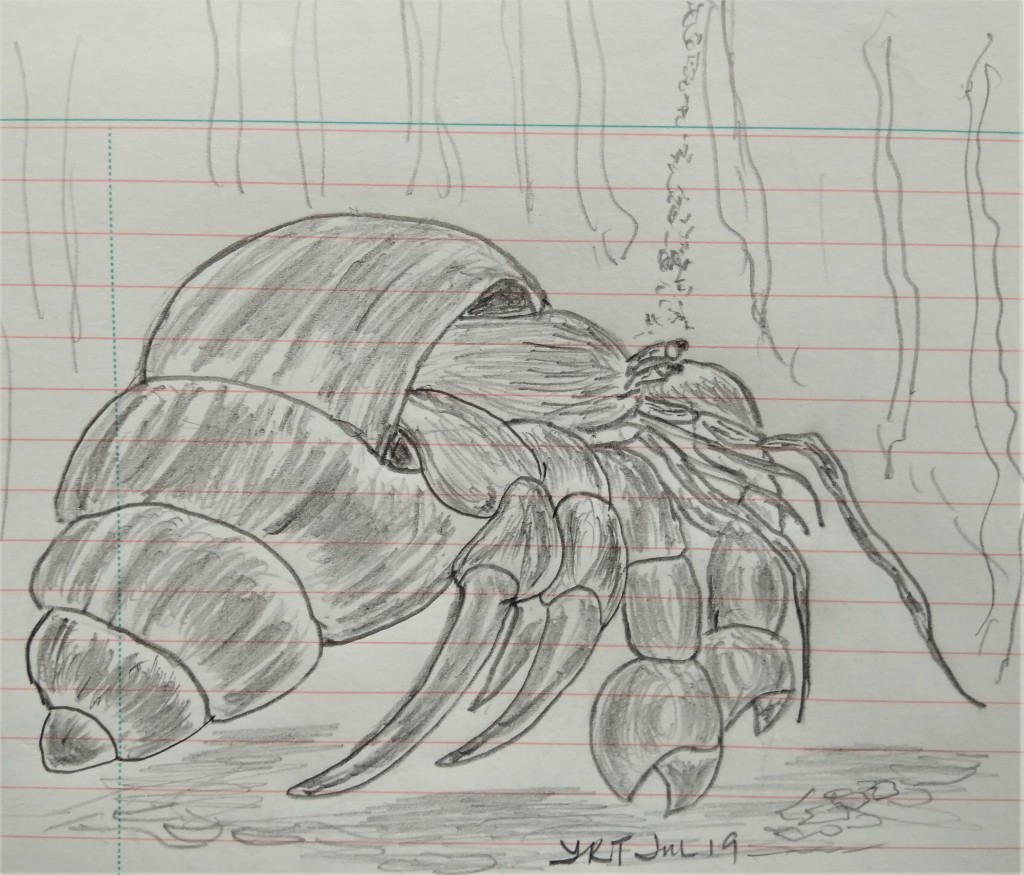
There are over 1000 different species of hermit crabs. The marine types live underwater, as detritivores, feeding on decaying matter in reefs and small prey while the terrestrial hermits live on wetlands. They change house as they grow, since their shells do not grow with them. Finding new homes can be competitive and essential as protection from predators that feed on their soft thorax. Like humans, they may exchange homes or hunt for new ones from another species and fights can occur. This is a story on Boris the hermit and his feisty neighbor Ferris the octopus.
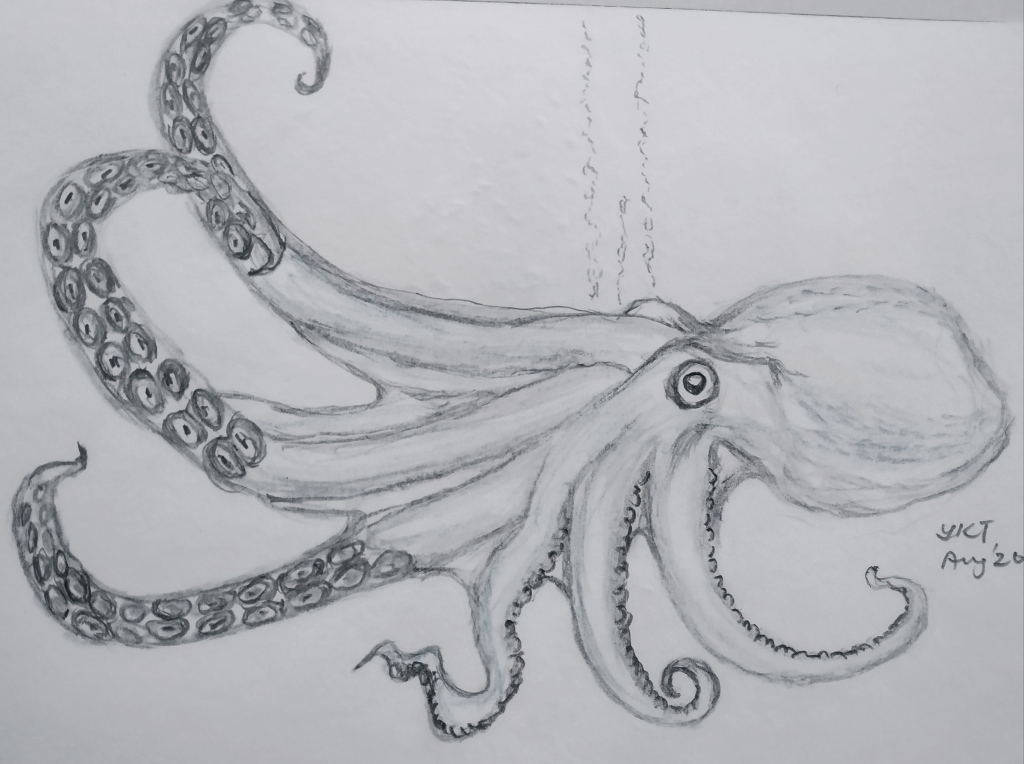
Now the octopus is a mollusc from the species octopoda as distinct from squids, cuttlefish and nautiloids belonging to the cephalopoda order. Boris always marvel at the multiple limbs (tentacles are part of the limbs) on Ferris, being able to multitask and catch eight prey at once, not to speak of his black jet defense mechanism and his turbojet propulsion. Also octopuses are smart – they are escape artistes and are known to remember learned movements. They have three hearts; the systemic circulates blood round the body and two branchials that pump it through each of the two gills. Their blood contains the copper-rich protein haemocyanin to transport oxygen. Everyday Boris would watch the octopus catching its prey with ease – a crab here and a skad there, sometimes several were caught in its eight limbs when a school of krill get caught in its tentacles. Boris would stumble along the reef beds to pick up decaying matter left behind after Ferris had a meal. He felt like a beggar in the food chain with Ferris living like a duke and him a bottom feeder. So Ferris grew bigger and stronger while Boris became more of a recluse like all hermits. Even getting out of his shell to hunt was a struggle – he would extend himself a little at a time and clamber around, carrying his house when the coast is clear, because a seal or a parrot fish can swim by and bite his claws off. Boris doesn’t want to be a hermit, but he had tried to be anything but a crab – he had looked to and spoken to the lion-fish, the dogfish, catfish, parrot-fish, frog-fish and even the clown-fish, monk-fish or the seahorse but all to no avail. So he withdrew more and more into his cloistered shell.
The psychiatric disorder of withdrawal in modern day living has become a trend with the pervasive preoccupation with internet surfing, computer gaming and smartphone addiction. Western society refer this as cocooning while Eastern traits of becoming a recluse for religious or monastic reasons had existed for decades. In Japan one study estimated there are more than 500 thousand hikkikomori individuals staying at home and avoiding social contacts as a stigma of failing in life. Studies in countries from South Korea, India, Spain shows a spectrum of social disorder ranging from social avoidance in one extreme to suicidal depression in the other. Much can be attributed to the disparity of one’s social standing and perceived material success with societal acceptance. Psychologists and criminologists must have correlated aberrant social behavior to this tendency of feeling rejected, resulting in social withdrawal and fomenting violent behavior as influenced by cyberspace. Now back to Boris.
One day Ferris spoke up. Boris, don’t try to be a whale or even a marlin or shark when you’re born a crustacean. You have a shell, why not use it, or build on it? That set Boris thinking. Ferris may be a nagarazoku (multi-talented) while I’m only a hikkikomori, but yeah, I will build my home, make it the most beautiful among the reefs. So from that day on, Boris kept a lookout for the most colorful and shining shell around. There were many – some discarded by former occupants because they outgrew them, others were just abandoned when predators pulled the flesh out of them. Then one day he beheld the most beautiful shell he’d ever set eyes on. It had green stripes interlaced with silvery grey pearly white and fading into shiny purple at the tip, brilliant and just his size. But it was occupied.
Of course he was fought back – who would not want to defend himself if somebody comes to take your house, or your wife? Now Boris may have been born a crab but a lack of determination is not his weakness. Faint hearts do not a fair lady win, nor a trophy to be seized. So he started stalking his desired new house. For days he would follow his target as it sought food on the reef-bed. He would even forsake food himself as he chased his desired shell. One day the current was strong and the target was chasing a morsel rolling on the sea floor. But because of the weight of its shell it could not catch up. Until it decided to crawl out of it to quickly catch its morsel. It was Boris’ chance. Quickly he crawled out, abandoned his home to catch up with his new shell. In a brief moment he was naked and vulnerable, his thorax a succulent meal for many reef predators lurking around. Then out of a reef bundle a moray eel darted out. Shoosh! it charged at the wriggling hermit crab bodies on the seabed. But it wasn’t Boris’ thorax that was eaten. Quickly he retreated into his new-found home, its previous owner now safely in the eel’s mouth. From that day on Boris felt a new sense of purpose, proud of his new home, prettiest among the reefs. But he was still a depressive hermit crab, scouring the darkened depths for dead tissues. Until a scuba diver came to visit.
Boris was nervously trying to come out of his beautiful home to get food when the diver swam by. He extended and then retreated back jerkily into the shell, quickly when the diver stopped to admire his home. Then suddenly a hand reached out and grabbed Boris, shell and all. For a while Boris remained fearfully retracted when he was transported out of the sea and onto a boat. After some time he was placed in a pot of seawater. Fearing the worse Boris remained tightly in his shell, until a few days later he was gently dropped into a glass enclosure, filled with sea grass, pebbles and other smaller fish. “Mommy! look at that pretty shell!”, a group of children shrieked from outside the aquarium. Boris realized there were no predators, only people outside ogling at his pretty shell. So if anyone of you feel being born a crab (or crap) rather than someone special or important, look at Boris. He had found his calling at last. A successful male model.

The narwhal’s tusk and the marlin’s bill
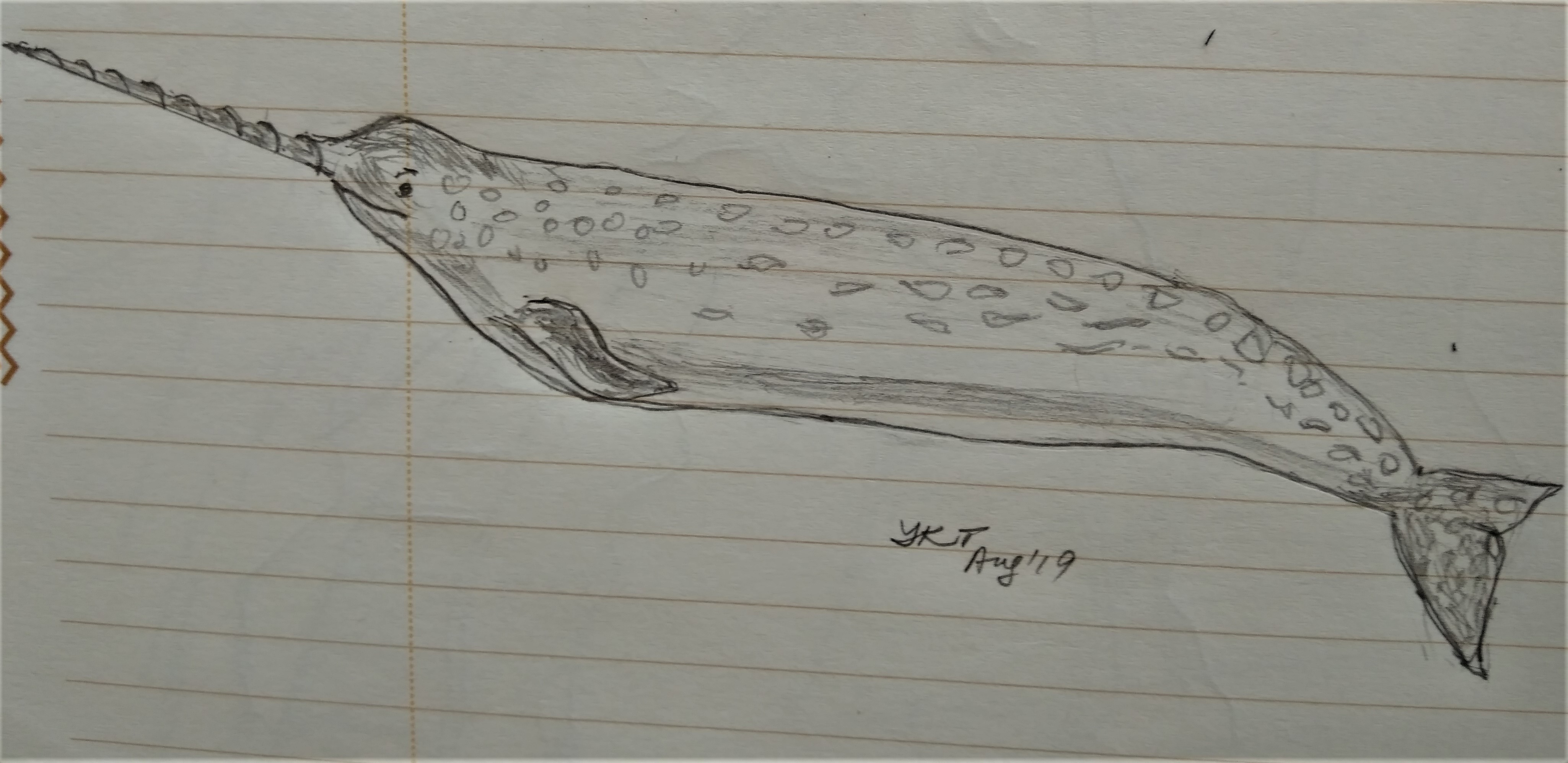
The narwhal (monodon monoceros) is a whale that lives mostly in arctic waters. Its distinct feature is its frontal tusk that looks like a marlin’s bill, except that it is an outgrowth of a tooth to sense echo and water pressure. The pre-molar helical outgrowth is seldom used as weapon unlike the marlin, and can grow as long as the whale itself – 3 meters. Narwhals are peaceable and hunted by the orca killer whales and its favorite diet is cod, halibut or flatfish. They are social mammals, keeping to their pod of four or five individuals. This is the story of Norsk a year-old narwhal. Not only does he like to roam, he has a quality that many humans lack – curiosity and a desire to know everything. So Norsk swam as far as he can from his pod, and explore everything he can find. The vast expanse of the Arctic was his playground, changing each season with the shifting ice. His curiosity taught him lessons of survival – like where the codfish or halibut tend to flock and where to avoid the fearsome orca hunting party. Although the leader of his pod is the matriarch female, she would depend on Norsk for hunting and navigation. One day the pod of five narwhals was threatened.
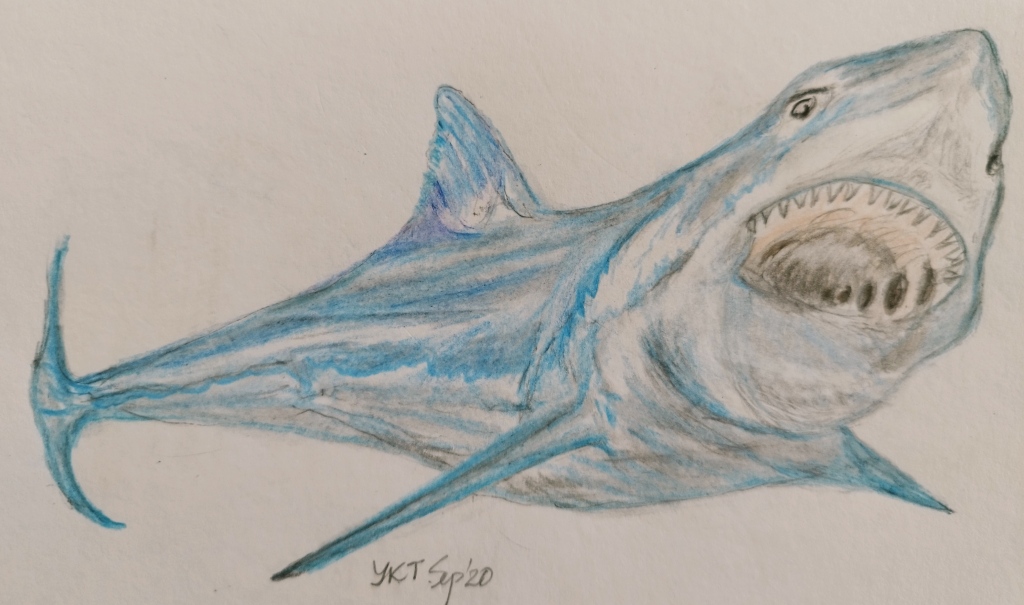
They were off the Newfoundland coast when a great white shark came out of the deep. It had been apparently stalking the pod. The narwhal’s first instinct was to separate to confuse the predator but it soon focused on Norsk. He swam as fast as he could, turning here and there to lose the great white. But it was too powerful and Norsk instinctively headed to the ice sheets. It was a smart move as sharks prefer warmer waters. As he looked back the shark disappeared but something bigger had taken its place. It was a giant marlin. Soon it jumped. It was almost as big as the shark. It flashed behind him, its bill slashing like a samurai sword.

Norsk knew that his tusk was no match, being a softer organ. But he also knew the terrain well, and that included the numerous gigantic floating ice. He dived under one. Foolishly the marlin followed. Under the white expanse, Norsk knew exactly where to turn and soon broke the marlin’s chase. After a while he remembered an opening in the ice cover and surfaced for air. What about the lost marlin? It was desperately looking to break the ice surface but soon ran out of air. Norsk turned back to rejoin his pod. On his way back under the ice he saw the marlin in the distant depths, weakened to a state of drowning, its bill circling in random motion. Brains had beaten brawn. But the narwhal had another weapon that would save the pod from other dangers – its echo-locating tusk cum thermometer/barometer. If you’re an arctic scuba diver under the ice, besides the usual precautions you must always know the way to surface for air, as we learned from the marlin. But if you happen to be near breaking ice sheets the danger increases. Norsk and his pod were always swimming round ice floes – their food supplies are always beneath them where zoo-plankton subsists. One day the pod was busy feeding, along with the seals and sea-eagles, grabbing fish from the water surface. Suddenly an orca appeared from nowhere – the hunting party had decided that its favorite seals were worth a grab. Norsk and his pod were not far away under the ice. Then an orca jumped.

It was a hunting tactic – to confuse the seals so that the rest of the orca could close in. But Norsk knew better – the splash from its jump had already reached his tusk as a pressure-wave. However his sensitive tusk detected something else – much bigger. Quick – get out of the ice-sheets! He seemed to shout at the other pod members. So the group of narwhals swiftly disappeared from the ice and dived deep. No sooner had they did that a gigantic piece of the ice mountain cracked open and slid violently into the sea. Some of the sea eagles were even washed under the surface. But it was a timely escape for the narwhals. Even if you are king of the ice, you can never argue with the force of Nature. Blame it on climate change.
Pardon my slowness I’m just a snail
There are about 60 000 species of snails (mollusc gastropoda) living on land and water. The giant African snail weighs a kilogram with a length of 100 mm while the shell of the tiny Augustopilla measures only 0.86 mm. There are tree snails, river snails, sea snails, rock mollusc and of course the garden variety which can be of various specie in different climates and altitude. They can breed quickly – after a monsoon season armies of snails can appear at a creek – much to the delight of many birds and fish (and humans) that feed on them. But not all humans are equally fast mentally or physically.
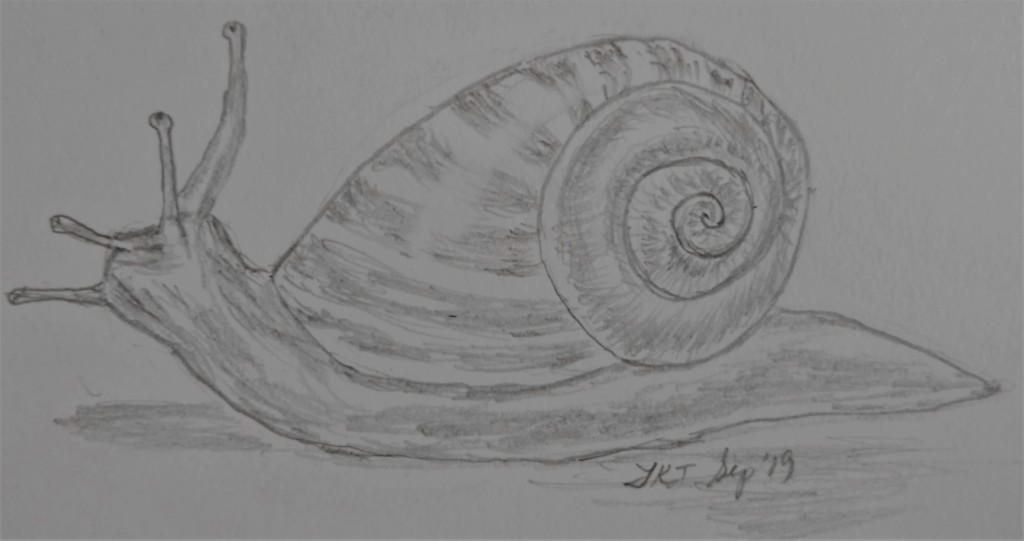
Between 3 to 10 percent of world human population are regarded as mentally challenged, the actual figures depending the degree of mental retardation. There are about 2% of autistic children born in the world and it is estimated that 3000 to 5000 children are born with Down’s syndrome annually. Humans have a natural disdain for others that are mentally “slower” than themselves and societal competition for top schools and top jobs have little regard for naturally retarded individuals. So the humble snail lives in a world of its own. It eats whatever it can find, such as algae, decaying vegetables or flesh and moves slowly to where it can survive (and reproduce) best. Harvey is one of those and he lives in the garden where a highly autistic 5-year old boy Davie lives.
About the only time when Davie remains de-stressed is when he plays in the garden, alone with all the little creatures he can find. Snails fascinate him. Simply because they are never in a rush to go anywhere. Davie will stare at them, talking softly and feeling the colors of every shell. The snails would withdraw quickly into their so-called skeletons, but would slowly reappear when Davie offers a small piece of cabbage which his mother kept in a box. So Davie plays with several at a time – a turban-shell, a hermit crab and several freshwater snails. Autism seems to do very well in a slow-moving, silent world with peaceable, quiet crawlers. Then one day Davie, in tears, came from the garden to her mother in the kitchen.
“I can’t find Harvey”, he said softly, head drooping. Well, lets go find together, her mother comforted. So leading him by the hand they looked and looked. After a while her mother spotted a shell wedged between two branches high on the papaya tree. Halvey is having fresh papaya juice today, proclaimed the mother. With a ladder, it was dislodged and placed in a cage so that Davie would not lose sight of it. Now make sure you feed Harvey, or else he’ll starve said the mother to Davie. So daily, Davie would go out cabbage leaf in hand to feed. It wasn’t long after that Davie came into the kitchen again. He had a serious look. “Halvey is not eating – I think he’s unhappy.” Well wouldn’t anybody be happy staying in a cage, her mother rejoined. So Davie tied a long string onto Halvey’s shell and leashed him to a tree. Happily Davie would look for Harvey at the end of the leash and they both went on famously together. On Sundays, they would go for a walk further out the garden. Davie would patiently wait for Harvey to snail along for a meter before taking a step. Sometimes he would climb up a branch and Davie would wait for Halvey to feed on something else. One time Harvey started digging the ground and Davie thought nothing of it. It was the raining season. Several days later when it was dry again Davie came looking. He was surprised and yelling for her mother. Surrounding Harvey were several other snails and they seemed to be bunched together. He rushed to the kitchen to report. After a quick look the mother calmly said. “Davie, Halvey is making babies. And another thing Harvey is a girl. See – she has many boyfriends. Let her alone and we’ll see what happens a few days later.”
Davie’s mother may not be entirely right. You see, many snail species are hermaphrodites – they are capable of producing sperms and eggs in their bodies and are hence able to self-fertilize, without the need for girlfriends or boyfriends. How nice ! – did I hear some teenager say? But the practice of bunching together in such an orgy of reproduction may be a strategy of gene-diversification. However it is fraught with danger. Firstly many spear themselves in the process and may hurt their own internal organs. And secondly, as any experienced humans know, the act of reproduction throws caution to the wind and snails have many predators waiting at the show to pounce in such vulnerable moments. What of Davie? As a curious 5-year old he could not pass up the opportunity of learning. So he borrowed his grandfather’s magnifying glass. For hours he saw things that will make many a lady blush, but Davie didn’t know better. So he ran to his grandfather. “Grandpa, please come to the garden – I’d like to show you something.” So grandpa obliged, bending down his creaky frame to peer through the lenses. “So are they having a good time at the party?”, Davie asked innocently. Yes, a mighty good time the grandfather replied, with a smirk on his face. Yep, those were the days, he quipped to himself, out of earshot.
Patience, concentration and a sense of wonder – Davie learned these from a humble snail. As he grew older he knew that he’ll have to learn separation as his grandpa said snails will at best live up to three years. That summer Davie fell sick and had to rest from a cold. For two weeks he could not venture into the garden to see or walk his friend. As soon as he recovered his mother let him out and he looked anxiously for Harvey. After pulling in the long leash he was horrified to find there was nothing at the end. On the ground was Harvey’s empty shell. A bird has probably taken Harvey, his mother explained. But don’t cry now, he’s had a good life, as the mother hugged the sobbing Davie. It was a sober moment for both, because not long later the grandpa passed on. Davie had been prepared for bereavement from a snail.
Courage is from the heart

The raccoon is generally shy, secretive and unfriendly. They are secretive by their habit of theft and banditry. And their bite in defense can be worse because of the rabies that if spread to humans are hardly curable. So the furtive behavior of raccoons to steal things is characterized by the “mask” of fur on its face – like the incognito Zorro. The raccoon does not show the indomitable spirit the African buffalo does. Especially with a herd of several standing together they are known to discourage a pride of hunting lions. So the buffalo gains courage from numbers, and the fact that their strength and size defies the apex predators. Then what about the warthogs? Their courage is indeed remarkable.
The warthogs (phacochoerus) are known to chase after predators to protect their young. Their horns which can grow as long as 10 cm are formidable weapons. Besides their hide – just like the African buffalo are tough enough to dispel the bites of lions. And what a face! Hard to tell where it begins and end – but you’re well to stay away from the tooth or horn.
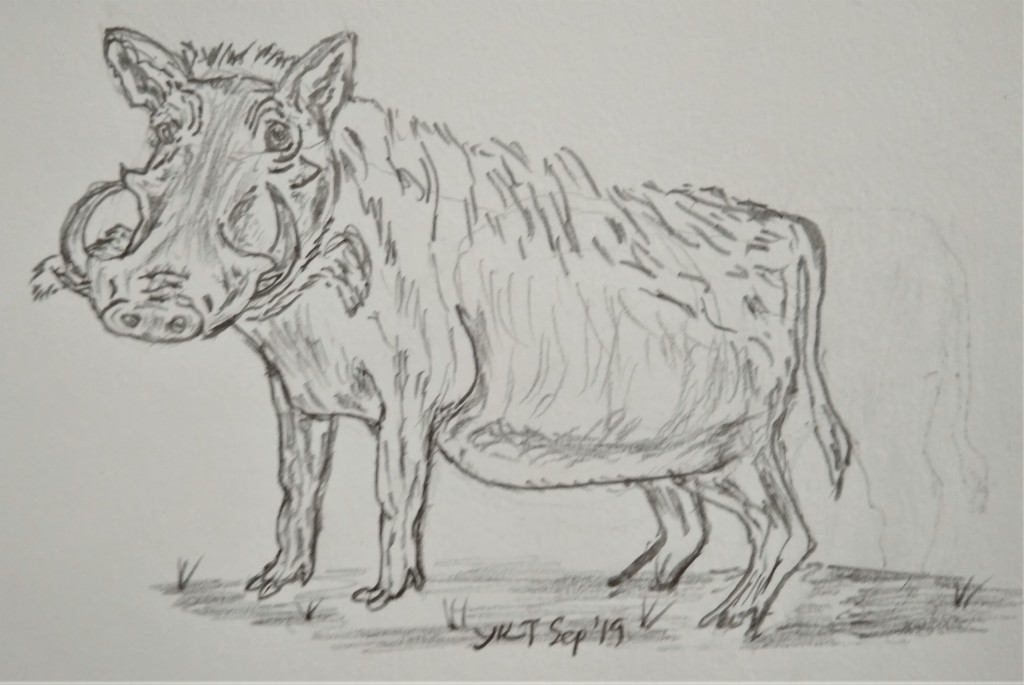
A father was trying to teach his son how animals display courage. They went on a safari, binoculars in hand in order to observe, first hand. Once in the lowlands near a creek they saw a leopard made its territorial rounds. It was a solo hunter, as all leopards are. But its next meal was never certain. In the occasional bush it would espy small rabbits and voles and they were never enough for its daily sustenance. So the leopard’s vantage point was a tree from which to smell out its prey. After several hours the sun set and it saw movement in a mound of grass. Raccoons. A family of 5 were out in a night raid, looking for abandon eggs in nests as well as digging for grubs of insects. The leopard lept down the gnarled tree in a fluid movement making as little noise as possible and slouched low in the grass for a moment, sniffing the air to ensure the wind direction would not betray him. Then he crawled forward stealthily, eyeing one raccoon as the target. But just as he got within the killing distance, a flock of heron suddenly took off from the nearby creek. “Run for your lives! every man to himself!”, the raccoons seemed to shout. The leopard stopped in his tracks and flopped down on the grass, defeated for once as the raccoons disappeared into their holes. The father turned to his son and said – “that’s what most people in the world do – run for yourself.” Not a few seconds later the leopard perked up its head as a rustling in the grass could be heard. There among the tall elephant grass a horned head poked out. It was an African buffalo, a shadow of its huge hunk outlined against the sky. The leopard licked his lips. Maybe I can take down just one, he seemed to think. But it was not to be. Out of the bush four beasts lumbered forth, their tails flicking back and forth to chase off the flies buzzing around. One glared at the leopard, having sensed its smell, and made several steps towards it. Emboldened, the other three also strove forward, their horns waving menacingly. Then they flared out in a semicircle towards the leopard, slowly advancing.

The leopard jumped off like a frightened cat and that ended the detente. Then the father said, “Courage in unity.”

The next day the safari party saw the same leopard in the gnarled tree. It was getting dark and it appeared to be really hungry. Then as dust fell, there was a squeal in the bushes. The leopard sat up, determined not to miss a meal this time. Four baby warthogs was playing while the mother was digging up some root nearby. The leopard jumped down softly and crouched. Slowly it made its way toward the unsuspecting family and in a flash caught one of the pups in its jaw. Squeals rang through the night as the leopard made off. What followed was enough to make the watching boy cry. The mother warthog took off after the leopard as the rest of her pups scattered. It was fast, like all hell broke loose. Though smaller than the leopard, it appeared as if the prey was chasing the predator. It was gaining on the leopard who quickly dropped the baby, but not before one of the mother’s horns gored its hinds. Sadly the leopard had to settle with small fare, like rabbits or moles for the night. And the baby? The mother carried it in her jaws back to the litter, almost lifeless. The father turned to his son who was visibly in tears. He would never forget his father’s next words – “Courage comes from the heart.”
Keep the change please – a lesson on temper
Apart from the octopus, there are roughly 300 different species of squids (cephalopods). The largest giant squid is known to be about 13 meters in size while the smallest can be minuscule. But the fascination common to them is the ability to demonstrate bio-luminescence – chromatophores mix two chemicals to produce light as fireflies do and use it either as a defense mechanism, foreplay or to signal territorial aggression. By controlling the size of their skin cells they vary the pattern, or even the color of these luminescence as a message to their predators, potential mate or adversary. Humans too show color in their face in response to emotions but in a much limited way compared to squids, which humans consume, some countries in large quantities. It has been stated (Mayo) that uncontrolled temper can be a health issue and people without proper anger management can stress themselves to ill-health. For someone able to hide their emotions at the right moment requires mental and moral strength and can be an admirable character trait indeed.
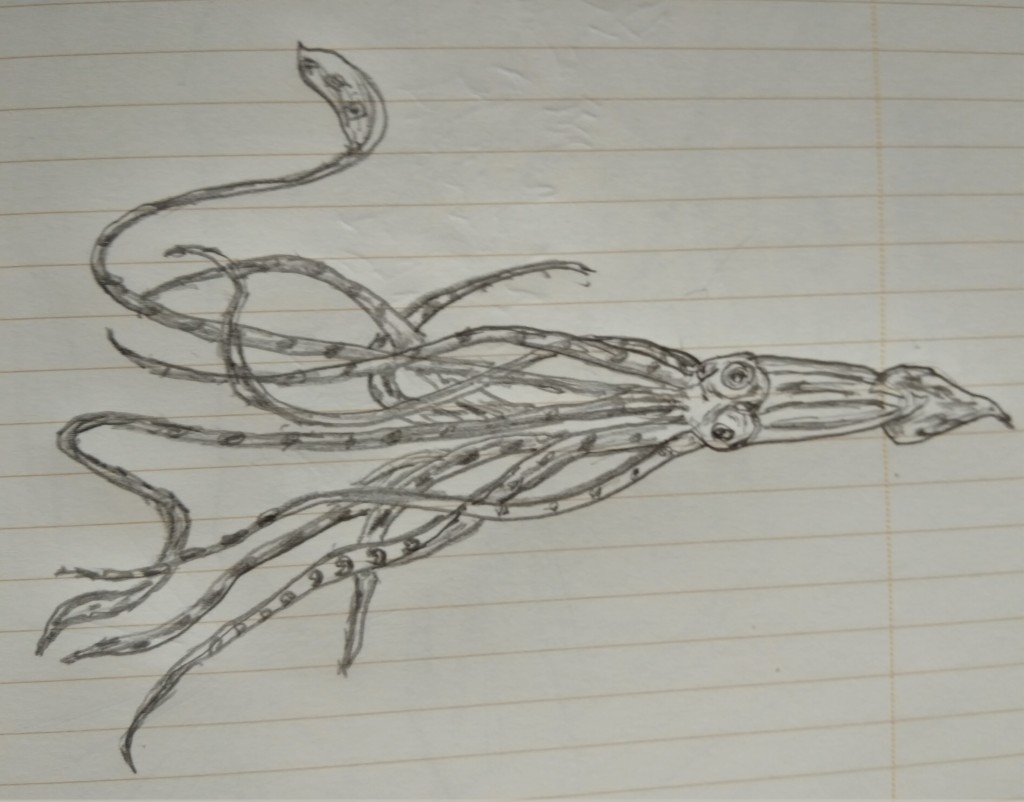
“Big” Ben had a traumatic childhood – since birth he often had uncontrollable temper tantrums which carried into his adolescence. All through adulthood he had to rein in his emotions but his passion in everything he does also brought lots of admiration. Ben loves rugby and his first lesson on temper took place in a league game. His large frame as hooker led to numerous dubious contact infringements during scrimmage. In one game he was so incensed with one of his adversary that he became bitterly personal. At the next opportunity he gave such an untimely tackle that the victim had to be carried out. His penalty was to sit out the season. Ben had learnt then never to use his large frame to bully someone weaker. He also had to learn group leadership. So he climbed the corporate ladder steadily and reached the top position in a large corporation, becoming its Chairman and CEO. Certainly his inability to manage his temper can be considered a character flaw not eschewed by many managers but his conviction and passion won the support of his superiors. For some it is a good problem, but still a problem in leadership. It eclipsed at a critical point in his company at a board meeting in deciding its future – a decision that had to be made at the day’s end. The secretary had locked the office door, with a note that it will only be opened at 6 pm when the board must decide.

The meeting proceeded smoothly until a major shareholder started to speak. Ben started to feel uneasy with this “nemesis director” until it reached a boiling point. Unable to control himself any longer he exploded with a hard crash of his fist, threw a few expletives to emphasize his convictions and left the boardroom in a huff. The rest of the directors had seen this before and continued discussions undeterred. After Ben slammed the door he saw the note at the locked door and proceeded to walk around the yawning office, still livid in anger. He was hyperventilating and had to really catch his breath. Then he walked past the aquarium and a curious item caught his eye. There in plain sight was a big fin reef squid, iridescent in all its colors. Its wavy body moved in sync with its tentacles in such peace that it stopped Ben in his tracks, fascinated. All these 5 years in the ornate office he had never noticed the creatures that lived meters away from his desk. The squid started to change colors – tiny dots in its wavy body changed from blue, violet, green and then red. Next to it was the plain female – the male squid was doing a once-in-a-lifetime courtship rites. It went on for 10 minutes and Ben had slowly recovered his composure, clearing his mind for what remains of the day. He turned towards the washroom to refresh himself, and missed the lurid sequence of the squids copulating. As he reentered the boardroom, he bowed deeply. A sudden silence fell. The other directors had never seen Ben done this in apologetic submission. But that 10 minutes break without Ben was truly needed and the subsequent discussions was filled with renewed vision and constructive ideas. The meeting ended dead on 6 pm, everyone with a satisfied look of amity on their faces. The secretary returned finding Ben seated on her chair, staring at the aquarium glass in deep thought. She cleared up for the day and wished her boss good evening to depart. Then just before she closed the door softly she said to her boss. “Ben, make sure you sign the invoice on your desk to replace the Big fin reef squids with new ones, as they will die soon. They will probably save your marriage just as they saved mine.”
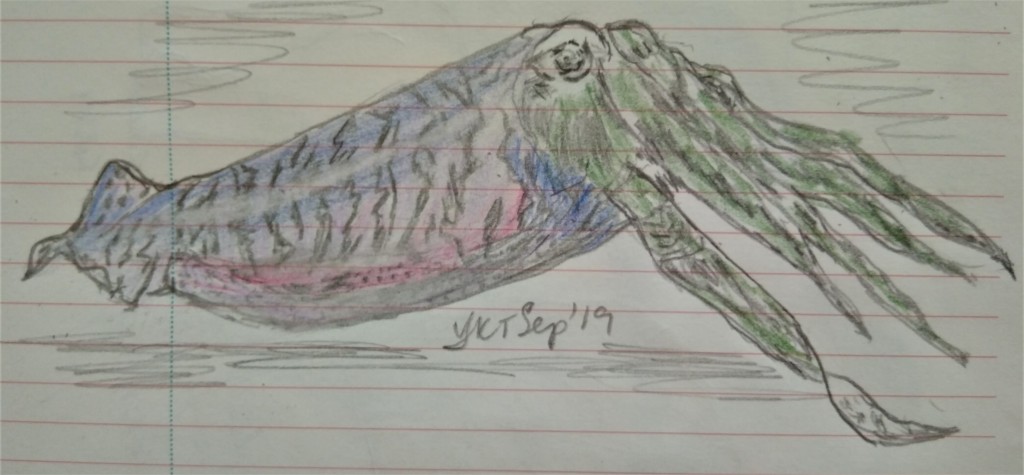
Truth stands up when the rooster crows
When does the rooster crow? Does it have an internal clock? Is it naturally sensitive to sunlight? The barnyard rooster cannot help but crow when its body senses light again since sunset. Unlike humans animals don’t lie, contrive or conspire an agenda nor betray hidden feelings. They declare themselves whenever their instincts tell them. They don’t play dead and the most deceptive mammals are those who camouflage themselves for survival or predatory action. Humans have been lying since early in creation. Whether blatantly or not, misrepresenting half-truths or spinning a story has been practiced from time immemorial and is second nature even in the highest office in the nation. The sad fact is that only in the most severe conditions, such as when one is under oath are humans subject to punishment. Almost all get away with a rebuke or regarded with suspicion as the punitive outcome. It is ironic that despite the fact that society cannot properly operate without truth and integrity at all levels of daily transactions, not telling the entire truth seems to be acceptable moral standard provided it is not explicitly punishable by law or order. This animal story is about truth and few stories hold such great importance to the health of society today.
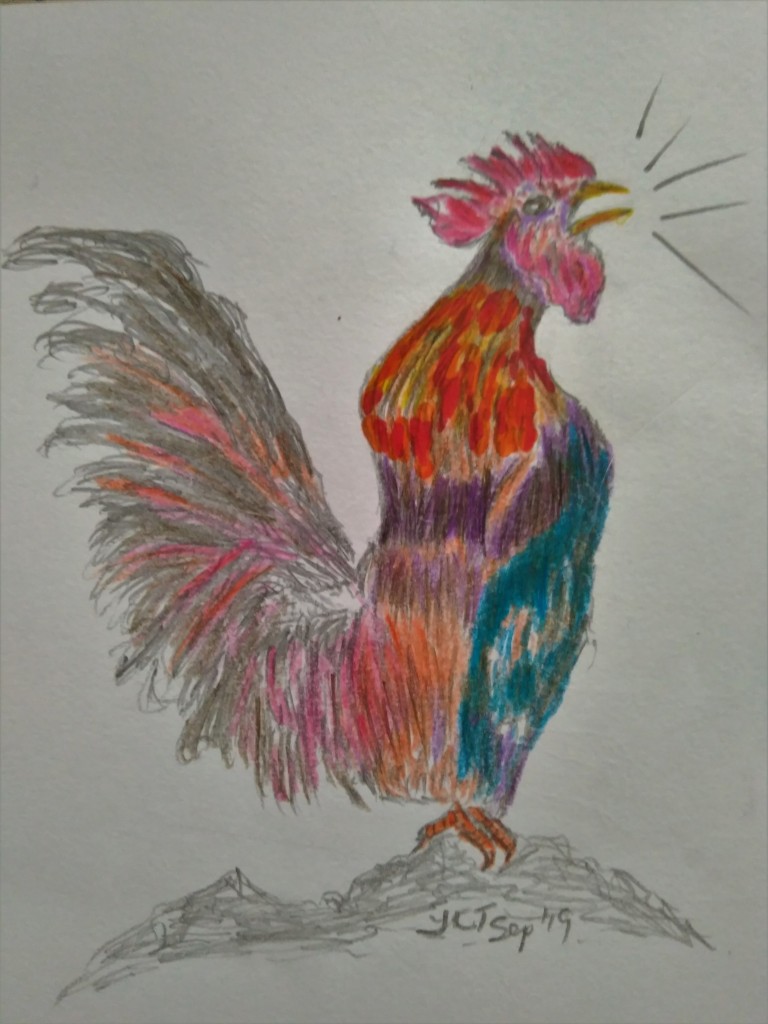
The Canadian geese mate for life. So are red crown cranes, wolves, swans, beavers, penguins, bald eagles and orcas. But not the barnyard rooster Attan. It normally keeps a coven of hens and chicks and seems his main job is to reproduce them and do the proverbial crow. He hangs around the poor and remote village of Senribu, Indonesia, when people knew the time to wake up by his 7am crow. Ahmed is the son of Darmojo who is the village elder and religious leader. His mother teaches the principles of Islam to the village girls. But 14 year old Ahmed is the prodigious son. He hates religious school and so ekes out a living running the streets. He grew up in the dog-eat-dog culture and became a reprobate cheat and liar. One morning his mother saw him chopping up several coconuts in the backyard. So she asked where did he got them. “Jamal gave them to me”, Ahmed referred to his cousin who lives down the track. The rooster crowed immediately. Without speaking the mother turned to go, noting that 7 am starts her religious class. Then another occasion Ahmed was seen by his father putting on fresh paint on a bicycle on the veranda. Where did you get that bike and why are you painting it? “I found it thrown aside on the roadside and I don’t like the color”, was the reply. The rooster then crowed. Hearing the rooster the father shook his head in disbelief. Just then the loudspeaker hailed for the 7 am prayer and he headed towards the village mosque. So it went on – Ahmed would bring home items like fish, fruits, a football and even a used TV. Each time the family would ask in the morning and he would give some innocent reply and, at every answer the rooster would crow. Until one day he was showing a newly acquired cellphone to Jamal, telling him that he found it dropped near the public lavatory. The rooster crowed twice. Not long later the local police came to Ahmed’s house. Someone had tracked the stolen cellphone on its server and caught Ahmed red-handed. It was 7 am. A quick search of the house followed and the police recovered several other items that Ahmed had stolen. Since Ahmed was the village elder’s son he was let off with only a warning. But Ahmed’s problem grew as he became older.
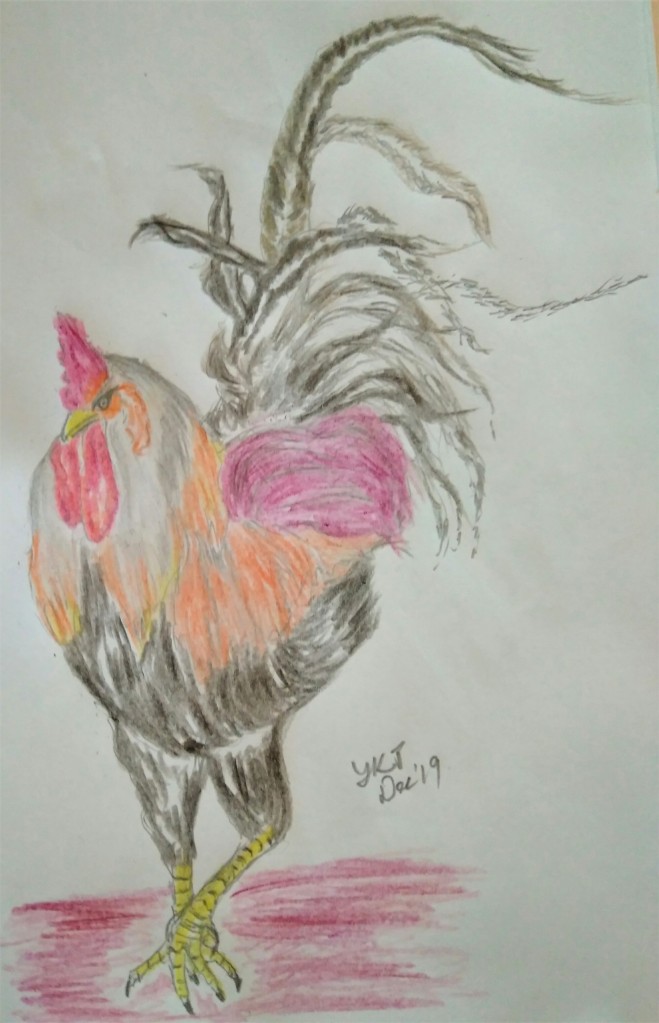
Ahmed became the village assistant chief due to his father’s influence. Some people protested having seen Ahmed behaved as a street urchin. But Ahmed held on. Years passed. Indonesia’s economy grew and many villages started modernizing by building flush toilets and electricity from solar power. When Senribu village’s turn to start these projects someone discovered something alarming. The village coffers were empty. Somebody had been siphoning all the villagers’ contributions for community development. An urgent village meeting was called at 7 am the next morning. Everyone pointed at Ahmed, the de-facto treasurer. He denied everything. Again the rooster crowed. Twice. It was then that Ahmed’s mother spoke up. She had noticed her son’s flamboyance the last few years in clothing and expensive watches. The village counsel decided to hold an inquiry and by the evening had collected all the evidence of Ahmed’s ill-gotten wealth from receipts he had kept. The counsel brought in Ahmed. Unable to defend himself Ahmed finally broke down and confessed bitterly, saying how difficult his poor background had been for him. In the silence that followed the rooster crowed. It was only 6 pm. For once Ahmed had told the truth.
Flying higher and faster – a lifetime dream of restoring self-esteem
If you like snow and blue mountains someday you should try exploring the Canadian Rockies. Somewhere beyond the magnificent Lake Louise in the Banff and Jasper peaks you might find a hidden valley. There are numerous lakes, some unnamed with a few unpronounceable ones. If you wish to get a little lost, try finding a little enchanted pond-like wetland, so little that it may not qualify to be a lake. That is if you can survive the biting cold and treated for hypothermia, because you can only get there on foot, after leaving your snowmobiles in the foothills. Isolated from most humanity you will find a family on which our story begins. On a frigid winter’s day you’ll probably find nothing but ice and snow. But come spring or summer all manner of waterfowls will congregate in this remote neck of the mountains. Necks, long and slender that stick out from the peripheral saw-grass identifies a flock of giant Canadian geese before they winter south. Strutting noiselessly on the placid water are coots, mallards, teals, widgeons or grebes, their heads tipping under occasionally while waving their behinds cheekily. The darling of the geese, Ethel wants to be first in everything but her mate Adel wants everything else. Ambition verses need. They are as different as day and night. You see Ethel was born strong and healthy and well groomed by her loving parents. Adel was born with a bent claw due to an accident few days after birth. But as often in real life the unlikely pair met and coupled right after they weaned into adults. Here in this unknown lake Ethel trained to rise from the water fast in a running sweep while Adel had to land without tumbling over from his misshapen web. If you think that is easy for birds wait till graduate school. When geese reach terminal speeds aerodynamics constrain them to fly in V-formation to optimize energy for the flock. The point bird however takes roughly 50% more drag, besides navigation. So in the long haul the others will rotate point position with the leader. Rather than lead Adel always wants to fly higher, because from small he had to struggle constantly to stay abreast with the flock. Ethel doesn’t mind lower, as long as she’s in front, but she really loves to fly. Adel’s mother had a hard time hatching him that winter of his birth. From a gosling he had this mental block perhaps transmitted to him during his mother’s anguish to raise him. Ethel however grew up fast mentally and physically – enjoying being leader of the flock and often the first taking the lead position. Whenever it was Adel’s turn to take over the lead he would sway with the wind-stream, unsure and clumsy with a mental torture to overcome. Through the years, Ethel was a natural leader and gives confidence to every bird in the flock. Adel? Well because he had to struggle at every turn, he became determined to succeed and his ambition knew no bounds. “Just watch me! One day I will lead the flock and surprise those who mock me every time I fly!” But the harder he tries, the greater the obstacles seem to become. Its like he’s fallen off the rails in life – struggling to get out of the groove from his bad start which haunts and curses him at every endeavor.
Geese fly long distances in their migration cycles – easily a quarter way round the globe. But why? Feeling the incoming cold of winter is not as compelling to leave as the absence of food like insects and greens. It is estimated that there are 4-6 million giant Canadian geese in North America but at the turn of the century (1950) they were near extinction due to over-hunting. They are mainly herbivores and are quite protective of their goslings.

However geese are easily taught by humans to be beggars, now that their numbers have extended to parks and near human dwellings. And Adel soon found that out. Every time the flock stops over and rest where humans are, he would depend on the easy scraps. He had become accustomed to bagged crispies. The greedy ones eat from junk thrown by thoughtless tourists while the healthier birds would look for greens or fish. “Adel, eat your veggies!”, Ethel would shout out at the gaggle running after the tourists, but Adel had just turned Indian, addicted to chili enchilada chips. But it brings us to a question. What do birds, or for that matter all living creatures do for a living? Do they actually have ambition and self-esteem?
The truth seems to be that all living things have two basic activities in life –food and sex. An overwhelming proportion of life is given to food for sustenance to keep the metabolism going. When the geese are flying, they need energy. Food is thus the cause but more food is the resulting need. You’d have thought humans are different. But the facts remain. From birth most of us have little choice of how life should be lived. The mental and physical formative years fly by with schools, sports and skills. At the back of our minds was always the agenda of the future and the endless train of preparation, tests and qualifications rolled on. We compete, excel and compete again, until we reach a stage of obsolescence and frailty. Why? So that we can live independently and comfortably with adequate food and sustenance. Ambition comes from wanting more of it and fame or admiration often complements that need. Some would disagree to say their life’s objective is to serve and do some noble cause. Sure, there are poor artists, missionaries, musicians or even golfers whose priorities are not food nor wealth, but that is their choice, after they had attained the minimum for life. We blindside ourselves forgetting that until we have the basic avenue of self-sustenance we cannot even begin to think. But unlike animals, humans have the ability to decide when we have enough and reverse the need from getting to giving. Back to Adel. He needed all he can get like the rest of his flock, more so because of his limitations. Who cares if food can be easily taken from humans. Then there’s the other activity. All living things from the humble worm to humans are normally born to reproduce. Somewhere and sometime in their DNA the process starts and culminates in adolescence. You might say, even for some mammals the process of forming the next generation becomes a matter of life and death. It is a bane for some developed countries when failure of a population to reach replacement rate threatens economic survival. Even politics struggle with replacing itself. And reproduction do have a run-out date.
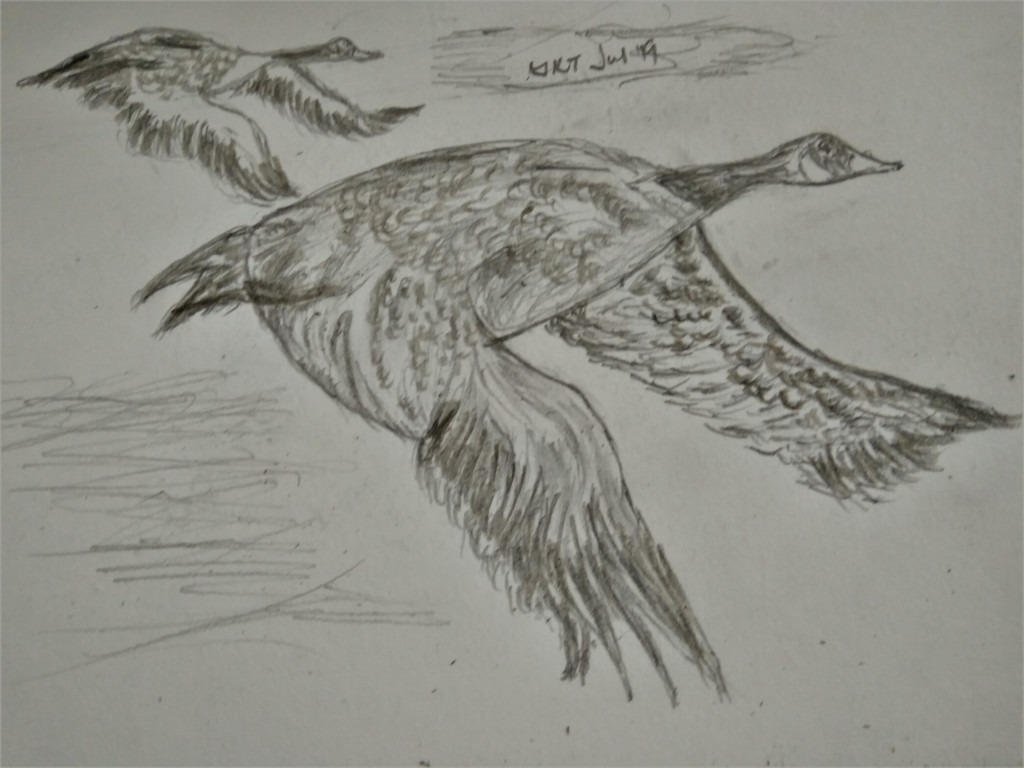
So one early spring the flock, as if knowing what to do in one mind took off in the easterly direction from their home lake. They landed in a nearby larger body of water to wait for summer. Some of them had started to shed their feathers. Weeks went by with the warmth and other birds were even shedding their wing tips. It’s the molting season. As summer came fully, the flock was only able to swim around. Though less heavy flight was impossible. But with much food available in summer this renewal process is assured. By midsummer the birds started to show signs of mating, kick-started by hormones designed in their DNA. Ethel and Adel had their work cut out, having reached the third year of growth. A series of events followed and soon the couple started jury duty – Ethel sitting on her clutch of 4 eggs to see if life can begin again. Adel would strut around to guard against invaders or trespassers. But like humans, animals also have their disappointments in love and marriage. Summer came and went, but the eggs failed to hatch. So that fall Adel decided to take a year off. Ethel soldiered on, wintering alone that year. Spring rolled around and that summer following Adel came back to join the flock, after the molting season. He found Ethel, still alone, sitting on another clutch of eggs! Such is the force of Nature. Despite monogamous geese, in the animal kingdom there are no adultery, cheating or affairs whatever and no marital claims against infidelity. Adel just got on with the hatching, playing guard as usual while Ethel tried for the adopted eggs. That autumn they celebrated two young chicks. If you think Adel should have been crushed again as a failed father, you might have a lesson here from the birds. He actually felt more confident and rewarded – it was the path out of his lowest self-esteem. Why? Because he did what needed to be done without the fuss if they had been humans. Adel would do that again in the following autumn and it was his life’s greatest achievement.
It was the hunting season – in North America that means anytime of the year…The flock was in its usual wintering journey, Ethel leading the arrow South. Standing in the tall wheat farms were two hunters, their scope focused on the leader. Then just before the trigger pull, suddenly a rear goose surged to the front, moving Ethel to the rear. The shot went off and the leader wheeled off towards the earth. Ethel stayed with the flock, shaken and not knowing what happened. But she knew she must stay the course – the way Adel overcame his low self esteem. So when the hunters came to pick up the fallen goose, one of them noticed it had a misshapen claw.
End of Volume I
